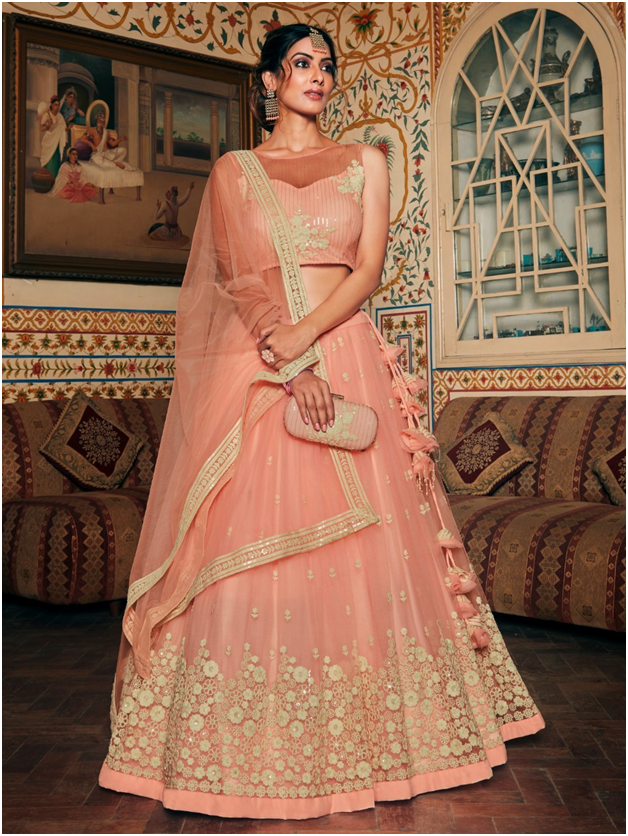Lehenga Choli is a three-piece outfit that includes a Lehenga, which is a long Indian gown worn by women all over India. It is a traditional Indian attire used at weddings, festivals, and other ceremonial occasions. It is fastened at the waist and leaves the midriff naked. It's usually embroidered, patterned, or ornamented, and it's paired with a choli or fitted shirt. A 'Dupatta,' which functions as a Sari Pallu and covers the mid-riff and head, depending on how it is wrapped for the event, is also worn with the Lehenga-Choli.
Origin
The Lehenga Choli became popular among women in the 10th century, especially in North India. With the emergence of the Mughals in India and their subsequent dominance from the 12th through the 18th centuries, the lehenga evolved through great workmanship. The original, old version of the lehenga was mostly made of cotton, but later royal materials and embroideries like silk and brocade were added, transforming the Lehenga into royal apparel.
Making
A Lehenga Choli dupatta pair or a Ghagra Choli requires at least twenty days of meticulous sewing, depending on the fabric and decorations. Because of the intricate craftsmanship, hand-stitched and hand-woven Lehengas take longer to make. Often, communities dedicated just to the creation of lehengas are assigned specific responsibilities as part of the overall process.
Diversities
Lehenga Choli continues to evolve through time, with cultural influences shaping its contour or style in the various variants of the Lehenga Choli that we are familiar with today. When it comes to classic styles, the Sharara, Gharara, and Lacha are just a few examples. Sharara, Lacha, and Gharara are lower garments that resemble flared pants and are from the 18th and 19th centuries. The three ensembles have one thing in common: they're all three-piece outfits with a shirt, long skirt, and dupatta material, and they're all popular for weddings. The Sharara has a joint just below or at the level of the knee, and the skirt below it extends out. A Kurti and one or more dupattas are worn with the Sharara. When wearing two dupattas, one is often utilized as a veil and the other is thrown over the shoulders. It is commonly seen during weddings.
Ghagras are similar to traditional skirts, but the distinction is that the Ghagra with pleats is worn around the waist, whereas the Lehenga is more form-fitting and cut in an 'A-line. Ghagra Cholis come in a variety of styles, including cotton Chaniya Cholis worn by Rajasthani and Gujarati women, and party dress Ghagra Cholis embroidered in georgette, crepe, or silk. Ghagra Cholis for weddings are heavily embellished with beading material, Swarovski crystals, rhinestones, Kundan, sequins, and other heavy decorations in brilliant colors and designs. Ghagra Cholis with tie and dye, as well as bead and mirror work Lehenga Cholis, are very popular.
The Gharara is a Sharara that has been divided in half and has a focus of work at the knee, also known as the goat. Lacha is made up of a long blouse dress material that almost reaches the knees. The skirt might be designed to match the Lehenga or Ghagra. This is a Ghagra with a small difference in the blouse. The classic lehenga comes in a variety of styles, including Lancha and Sharara.




















 sunrise
StableDiffusion
sunrise
StableDiffusion
 bonfire friends
StableDiffusion
bonfire friends
StableDiffusion
 sadness
StableDiffusion
sadness
StableDiffusion

 purple skies
StableDiffusion
purple skies
StableDiffusion

 true love
StableDiffusion
true love
StableDiffusion
 My Cheerleader
StableDiffusion
My Cheerleader
StableDiffusion
 womans transformation to happiness and love
StableDiffusion
womans transformation to happiness and love
StableDiffusion
 future life together of adventures
StableDiffusion
future life together of adventures
StableDiffusion





















